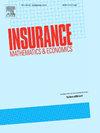The principle of a single big jump from the perspective of tail moment risk measure
IF 2.2
2区 经济学
Q2 ECONOMICS
引用次数: 0
Abstract
Consider a financial or insurance system with a finite number of individual components. The famous principle of a single big jump (PSBJ) says that a system crisis occurs mainly due to a single but unusually large loss from some individual component. Most of literatures modeled the PSBJ through the tail probabilities of the largest risk and the total risk of the system. Different from the existing works, this paper is devoted to explore the PSBJ from a new perspective. We aim to establish the PSBJ based on a kind of risk measure defined via the tail moments of the related risks. Our study is mainly conducted under a widely used framework, in which the individual risks are pairwise asymptotically independent and have the distributions from the Fréchet or Gumbel max-domain of attraction. The asymptotic behavior of the tail mixed moments is also discussed in detail. The results obtained are applied to an optimal capital allocation problem based on a tail mean-variance model. A numerical study is given to illustrate the accuracy of our main asymptotic results. We also give a thorough discussion on some interesting theoretical properties regarding the PSBJ.
从尾矩风险测度的角度分析了单次大跳跃的原理
考虑一个具有有限数量的独立组件的金融或保险系统。著名的单次大跳跃原理(PSBJ)认为,系统危机的发生主要是由于单个组成部分的单一但异常巨大的损失。大多数文献通过系统最大风险和总风险的尾部概率对PSBJ进行建模。与已有的研究不同,本文试图从一个新的角度来探讨PSBJ。我们的目标是基于一种由相关风险的尾矩定义的风险度量来建立PSBJ。我们的研究主要是在一个广泛使用的框架下进行的,在这个框架下,个体风险是两两渐近独立的,并且具有来自吸引力的fr切特或Gumbel极大域的分布。文中还详细讨论了尾部混合矩的渐近特性。将所得结果应用于基于尾部均值-方差模型的最优资本配置问题。最后给出了一个数值研究来说明我们的主要渐近结果的准确性。我们还对PSBJ的一些有趣的理论性质进行了深入的讨论。
本文章由计算机程序翻译,如有差异,请以英文原文为准。
求助全文
约1分钟内获得全文
求助全文
来源期刊

Insurance Mathematics & Economics
管理科学-数学跨学科应用
CiteScore
3.40
自引率
15.80%
发文量
90
审稿时长
17.3 weeks
期刊介绍:
Insurance: Mathematics and Economics publishes leading research spanning all fields of actuarial science research. It appears six times per year and is the largest journal in actuarial science research around the world.
Insurance: Mathematics and Economics is an international academic journal that aims to strengthen the communication between individuals and groups who develop and apply research results in actuarial science. The journal feels a particular obligation to facilitate closer cooperation between those who conduct research in insurance mathematics and quantitative insurance economics, and practicing actuaries who are interested in the implementation of the results. To this purpose, Insurance: Mathematics and Economics publishes high-quality articles of broad international interest, concerned with either the theory of insurance mathematics and quantitative insurance economics or the inventive application of it, including empirical or experimental results. Articles that combine several of these aspects are particularly considered.
 求助内容:
求助内容: 应助结果提醒方式:
应助结果提醒方式:


